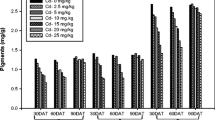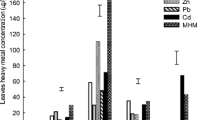Abstract
The screening of hyperaccumulators is still very much needed for phytoremediation. With properties such as strong tolerance to adverse environment, fast growing and highly reproductive rate, weed species may be an ideal plant for phytoremediation. The objectives of this study were to examine the tolerance and hyperaccumulative characteristics of 24 species in 9 families to Cd, Pb, Cu and Zn by using the outdoor pot-culture experiment. In the screening experiment, only Conyza canadensis and Rorippa globosa displayed Cd-hyperaccumulative characteristics. In a further concentration gradient experiment, C. canadensis was affirmed that it is not a Cd hyperaccumulator. Only R. globosa, indicated all Cd hyperaccumulative characteristics, especially Cd concentration in its stems and leaves were higher than 100 mg/kg, the minimum Cd concentration what a Cd-hyperaccumulator should accumulate. Thus, R. globosa was further validated as a Cd-hyperaccumulator.
Similar content being viewed by others
References
Baker, A. J. M., & Brooks, R. R. (1989). Terrestrial higher plants which hyperaccumulate metallic elements — a review of their distribution, ecology and phytochemistry. Biorecovery, 1, 811–826.
Baker, A. J. M., McGrath, S. P., & Sidoli, C. M. D. (1994). The possibility of in situ heavy metal decontamination of polluted soils using crops of metal-accumulating plants. Resources, Conservation and Recycling, 11, 41–49.
Basic, N., Keller, C., Fontanillas, P., Vittoz, P., Besnard, G., & Galland, N. (2006). Cadmium hyperaccumulation and reproductive traits in natural Thlaspi caerulescens populations. Plant Biology, 8, 64–72.
Brooks, R. R., Chambers, M. F., & Nicks, L. J. (1998). Robinson B.H., Phytomining. Trends in Plant Science, 3, 359–362.
Brooks, R. R., Lee, J., & Reeves, R. D. (1977). Detection of nickliferous rocks by analysis of herbarium species of indicator plants. Journal of Geochemical Exploration, 7, 49–77.
Brooks, R. R., & Radford, C. C. (1978). Nickel accumulation by Buropean species of the genus Alyssum. Proceedings of the Royal Society of London, Series B. Biological Sciences, 200, 197–04.
Chaney, R. L., Malik, M., & Li, Y. M. (1997). Phytoremediation of soil metals. Current Opinions in Biotechnology, 8, 279–284.
Dahmani-Muller, H., Oort, V. F., & Balabane, M. (2001). Metal extraction by Arabidopsis halleri grown on an unpolluted soil amended with various metal-bearing solids: a pot experiment. Environmental Pollution, 114, 77–84.
Fayiga, A. O., & Ma, L. Q. (2006). Using phosphate rock to immobilize metals in soils and increase arsenic uptake in Pteris vittata. Science of the Total Environment, 359, 17–25.
Huang, J. W., & Cunningham, S. D. (1996). Lead phytoextraction: species variation in lead uptake and translocation. New Phytologist, 134, 75–84.
Ince, N. J., Dirilgen, N., Apikyan, I. G., Tezcanli, G., & Ustun, B. (1999). Assessment of toxic interactions of heavy metals in binary mixtures: a statistical approach. Archives of Environmental Contamination and Toxicology, 36, 365–372.
Kong, L. S. (1982). Accumulation, tolerance and variation of plant to heavy metal. Environmental Science, 1, 65–69.
Kramer, U., Cotter-Howells, J. D., Charnock, J. M., Baker, A. J. M., & Smith, J. A. C. (1996). Free histidine as a metal chelator in plants that accumulate nickel. Nature, 379, 635–638.
Liu, W., Shu, W. S., & Lan, C. Y. (2004). Viola baoshanensis a plant that hyperaccumulates cadmium. Chinese Science Bulletin, 1, 29–34.
Ma, L. Q., Komar, K. M., Tu, C., Zhang, W., & Cai, Y. (2001). A fern that hyperaccumulates arsenic. Nature, 409, 579.
Malaisse, B., Gregoire, J., Morrison, R. S., & Reeves, R. D. (1979). Aeolanthus biformifoliu: a hyper accumulator of copper from Zaire. Science, 199, 887–888.
Ortiz, D. F., Ruscitti, T., McCue, K. F., & Ow, D. W. (1995). Transport of metal-binding peptides by HMT1, a fission yeast ABC-type vacuolar membrane protein. Journal of Biological Chemist, 270, 4721–4728.
Reeves, R. D. (2003). Tropical hyperaccumulators of metals and their potential for phytoextraction. Plant and Soil, 24,9, 57–65.
Reeves, R. D., & Brooks, R. R. (1983). Hyperaccumulation of lead and zinc by two metallophytes from a mining area of central Europe. Environmental Pollution, 31, 227–287.
Solís-Domínguez, F. A., González-Chávez, M. C., Carrillo-González, R., & Rodríguez-Vázquez, R. (2007). Accumulation and localization of cadmium in Echinochloa polystachya grown within a hydroponic system. Journal of Hazardous Materials, 141, 630–636.
Sun, T. H., Zhou, Q. X., & Li, P. J. (2001). Pollution ecology. Beijing, China: Science Press.
Wei, S. H., & Zhou, Q. X. (2006). Phytoremediation of cadmium-contaminated soils by Rorippa globosa. Environmental Science and Pollution Research, 3, 151–155.
Wei, S. H., Zhou, Q. X., & Liu, R. (2005). Utilization of weed resource in the remediation of soils contaminated by heavy metals. Journal of Natural Resource, 20, 432–440.
Wenzel, W. W., & Jockwer, F. (1999). Accumulation of heavy metals in plants grown on mineralized soils of the Austrian Alps. Environmental Pollution, 104, 145–155.
Xia, J. Q. (1996). Detail explanation on the state soil-environment quality standard of China. Beijing, China: Chinese Enviromental Science Press.
Xue, S. G., Chen, Y. X., Reeves, R. D., Baker, A. J. M., Lin, Q., & Fernando, D. R. (2004). Manganese uptake and accumulation by the hyperaccumulator plant Phytolacca acinosa Roxb. (Phytolaccaceae). Environmental Pollution, 131, 393–399.
Yang, X. E., Long, X. X., Ni, W. Z., & Fu, C. X. (2002). Sedum alfreii H: a new Zn hyperaccumulating plant first found in China. Chinese Science Bulletin, 47, 1634–1637.
Zhang, Z. C., Gao, X., & Qiu, B. S. (2008). Detection of phytochelatins in the hyperaccumulator Sedum alfredii exposed to cadmium and lead. Phytochemistry, 69, 911–918.
Zhou, Q. X., & Song, Y. F. (2004). Remediation of contaminated soils principles and methods. Beijing, China: Sciences Press.
Author information
Authors and Affiliations
Corresponding author
Rights and permissions
About this article
Cite this article
Wei, S., Zhou, Q., Xiao, H. et al. Hyperaccumulative property comparison of 24 weed species to heavy metals using a pot culture experiment. Environ Monit Assess 152, 299–307 (2009). https://doi.org/10.1007/s10661-008-0316-4
Received:
Accepted:
Published:
Issue Date:
DOI: https://doi.org/10.1007/s10661-008-0316-4




